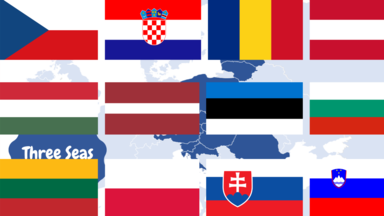"There are 120 million EU citizens in the Three Seas region and the Three Seas is now a huge part of Europe's economic growth, and the fastest-growing part of Europe", with these words Poland's President Andrzej Duda praised the initiative at the meeting of its member states in Sofia on July 8-9, 2021. The Three Seas Initiative, which was launched in August 2016, owes its creation to the efforts of Polish President Duda and former Croatian President Kolinda Grabar-Kitarović. With the initiative, which counts 12 member states now - Estonia, Latvia, Lithuania, Poland, the Czech Republic, Slovakia, Hungary, Slovenia, Austria, Croatia, Romania and Bulgaria - the two presidents intended to strengthen cooperation in Central and Eastern Europe and to boost economic development in the countries between the Baltic Sea, the Black Sea and the Adriatic Sea.
The U.S. think tank Atlantic Council drew the attention of the two presidents to the untapped economic potential of the countries that were isolated from Western Europe on the other side of the Iron Curtain not long ago. Compared to Western Europe, some of these countries still lag behind economically today and often suffer from outdated infrastructure. To overcome this economic disparity in Europe, the Three Seas Initiative aims to strengthen cooperation in Central and Eastern Europe, and to promote necessary investments in energy, transport and digital infrastructures. Hereby, the focus lies primarily on expanding North-South infrastructure which is years behind the European East-West axis. This in turn will hopefully attract more investors and subsequently promote economic development and the competitiveness of the region.
Broadly speaking, the Three Seas Initiative pursues the following six objectives: economic growth, investment growth, energy security, geopolitical interests, digital advancement and climate protection. To realize these objectives, an Investment Fund was opened as part of the Three Seas Initiative. This fund helps finance the joint macro-regional projects of the initiative. 51% of the projects supported by the initiative can be attributed to the transport sector. 32% of the projects are part of the energy sector, and only 17% of the Three Seas projects belong to the digital sector.
While the intentions and objectives of the Three Seas Initiative are commendable, some member states question whether the initiative is actually capable of meeting its ambitious goals. Additionally, some European states repeatedly express concerns about whether the forum is in line with the European Union or whether the initiative is rather driving a wedge between Western and Eastern member states of the EU. Officially, the initiative is intended to exist complementary, not in competition, to the EU. The initiative is no inter-state organization with the intention of undermining the EU, but an informal forum for states that wish to improve bilateral and multilateral sub-regional relations at the European level. However, the fact that the initiative was initiated by Poland's EU-skeptical President Duda has stirred up skepticism and mistrust among EU countries – at the beginning, the Czech Republic was particularly suspicious of the Three Seas Initiative's aspirations.
In fact, the perspectives of the member states on the initiative vary considerably. Member states differ not only in their expectations, support and interests, but also in their understanding of what role major powers such as Russia, China, the United States and Germany should play in this initiative. U.S. Secretary of State Michael Popeo's announcement at the 2020 Munich Security Conference that his country will invest $1 billion in the development of the countries of the initiative demonstrated the interest that the United States has in strengthening relations with Central and Eastern Europe. This promise, in turn, reinforced Hungary's interest in the Three Seas Initiative. However, US support is not altruistic; rather, geostrategic considerations play a role, as the United States seeks to protect its hegemonic standing in the world.
China and Russia also aim to expand their influence in this part of Europe, though. Primarily for this reason, the twelve states have found themselves in the economic and political initiative. The countries in the region, which are largely dependent on Russian energy, long for independence from the state which in the past has often exploited this dependency as blackmail to pursue its own national interests. Poland, Lithuania, Latvia, Estonia and Romania, in particular, recognize the need to strengthen their strategic partnerships with the West and especially the United States.
A comparison of the member states of the Three Seas Initiative, in particular of their expectations and opinions about the initiative and their relations with Germany, the US, China, and Russia will provide clarity on the aspirations and the future of the initiative. The following articles present an overview of each member state's perspective on the initiative. Interviews with country-specific experts offer additional insight into these relations.
About the author:
Valerie Kornis completed an internship at the Central Europe and Baltic States Project Office. She graduated with a Bachelor of Science in International Relations and Organisations from Leiden University in The Netherlands and is currently pursuing a Master’s degree in Human Rights and Humanitarian Action at Sciences Po in Paris.





